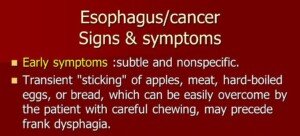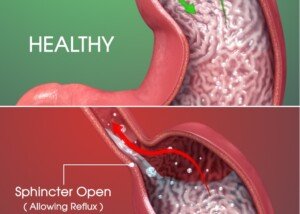GERD can lead to esophageal cancer.
But how long does it take for the chronic acid reflux to turn into this very deadly cancer?
The overall survival rate for esophageal cancer is only about 20% after five years.
This is because usually, once the symptoms begin, the cancer has already spread outside of the GI tract.
The symptoms include not only the feeling of food being stuck in the middle of the chest, but also this actually happening, because the tumor makes it difficult for food to reach the stomach.
As the tumor grows, it gets easier for food to get blocked, and eventually, it’s regurgitated back up.
Time It Takes GERD to Turn into Esophageal Cancer
“Firstly, it is important to note that only a very tiny proportion of patients with GERD will ever develop esophageal cancer,” says Santosh Sanagapalli, MD, a consultant gastroenterologist, endoscopist and specialist in esophageal disorders.

Shutterstock/solar22
“The type of cancer which is associated with chronic GERD is esophageal adenocarcinoma,” continues Dr. Sanagapalli.
“Cancer is thought to develop in GERD in a stepwise manner, and cancer does not develop overnight.
“Some patients with chronic GERD will undergo a change in types of lining cells in the esophagus.
“This is in response to chronic exposure to stomach acid.
“The lining cells turn from esophageal type into those resembling stomach or intestinal lining cells to protect themselves from the acid exposure.
“This change is termed Barrett’s esophagus.
“This process is thought to typically take many years to decades (and in many patients with GERD may never happen at all).
“Barrett’s esophagus is still benign, but carries an increased risk of developing into cancer.
“The majority of cases of esophageal adenocarcinoma arise from segments of pre-existing Barrett’s esophagus.
“Again, Barrett’s esophagus can progress to cancer in a stepwise fashion.”
The Steps of Barrett’s Esophagus
“Firstly, dysplasia can develop within Barrett’s cells – dysplasia refers to a further change in the lining cells which is a direct precursor to cancer,” says Dr. Sanagapalli.
“Dysplasia can be of low or high grade. Eventually, high grade dysplasia progresses to cancer.
“Barrett’s esophagus occurs in only a small proportion of all those with GERD.
“In patients who have developed Barrett’s esophagus, the annual risk of developing cancer is about 0.25%.
“In other words, of every 400 patients with Barrett’s esophagus, one will develop cancer each year.
“If Barrett’s with high grade dysplasia is present, the risk is higher at 6% developing cancer each year.” That’s six out of a hundred Barrett’s patients per year.
Though 0.25% to 6% may seem like a pretty small range, you should not let your guard down when it comes to managing GERD and seeing your doctor about worrisome symptoms.
What makes symptoms worrisome?
• They’re getting worse or persisting despite drug treatment.

• You’ve changed your diet to only very soft foods because items like meat, cereal, salads, apples, cookies, chips and even bread seem to get trapped in your chest and often come back up.
• You have unexplained weight loss.
“The risk factors for Barrett’s esophagus and esophageal adenocarcinoma include being overweight or obese, smoking, male gender, Caucasian ethnicity and age over 50,” says Dr. Sanagapalli.
“Patients who have a number of risk factors may risk progressing to cancer faster.”
 Dr. Sanagapalli is a gastroenterologist and director of the Esophageal Disorders Center at St Vincent’s Hospital, Darlinghurst. He performs diagnostic and therapeutic endoscopic procedures, and enjoys providing comprehensive and holistic care to patients with a wide variety of disorders affecting the gastrointestinal tract.
Dr. Sanagapalli is a gastroenterologist and director of the Esophageal Disorders Center at St Vincent’s Hospital, Darlinghurst. He performs diagnostic and therapeutic endoscopic procedures, and enjoys providing comprehensive and holistic care to patients with a wide variety of disorders affecting the gastrointestinal tract.
 Lorra Garrick has been covering medical, fitness and cybersecurity topics for many years, having written thousands of articles for print magazines and websites, including as a ghostwriter. She’s also a former ACE-certified personal trainer.
Lorra Garrick has been covering medical, fitness and cybersecurity topics for many years, having written thousands of articles for print magazines and websites, including as a ghostwriter. She’s also a former ACE-certified personal trainer.
.










































